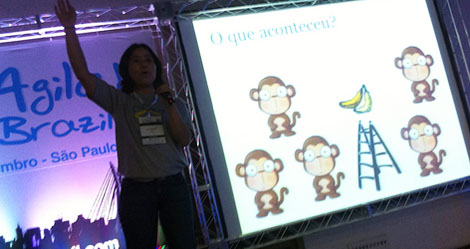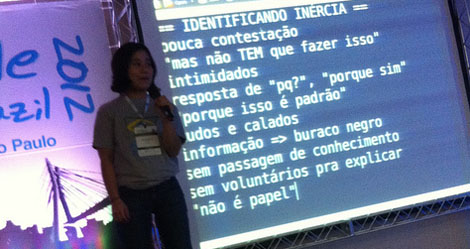 ][1]
][1]Then how to escape this behavior with newbies?
The Caelum in 2009 was certainly small but after 3 years, many changes still remain within the company, and in a team that believed in agility and its benefits, we still worry about being agile?
But first, we need to define what agility is, because they are still using automated tests, collective code ownership, courage, and other practices, but the uncertainty of agility worries us.
Because having practices doesn’t mean we’re still remaining agile, and it’s there that we notice we’re losing sight of why things matter, followed by more and more practices in place, with people asking “why not?” It’s a bit like the monkey experiment, everyone does what everyone else is doing!!
But for Cecilia, without understanding the why, there is no innovation, no change… it’s inertia!
So much is done, but always at the same pace, constantly avoiding innovation.
Automated tests are excellent.
Would you do these tests for a script that will run once and never be changed again?
Three lines of code can be tested automatically, and not to pass shame and not break the inertia.
Practice is not a rule!
Doing something unnecessary just because it’s institutionalized doesn’t move us towards anything better!
At this point, we stopped to do two practices first: “How to identify inertia” and then “rescuing agility”, generating a debate and knowledge exchange!
Listed on the photo screen below, we see identifiers of inertia such as many “because yes” in your team!! 

- agility, and as something good and important, there was an internal change shared with various initiatives made!
First, many ways were created for sharing knowledge within the entire team, through events like “brown bags” and incentives/calls to participate in company events.
Then, a cultural change was generated in encouraging novice iteration, so that they teach, “who teaches learns twice”.
Technical lunches for newbies were set up, warm requests for involvement in discussion lists, post creation.
If nothing resolves… let everyone make mistakes, this way it may be possible to reinitiate the process through a new search on how to solve them and believing in decision-making to get out of inertia, better change than just another brick on the wall!
See the presentation video at infoq: http://www.infoq.com/br/presentations/novatos-time-agil